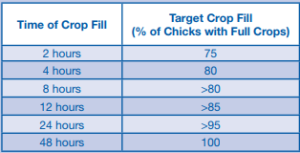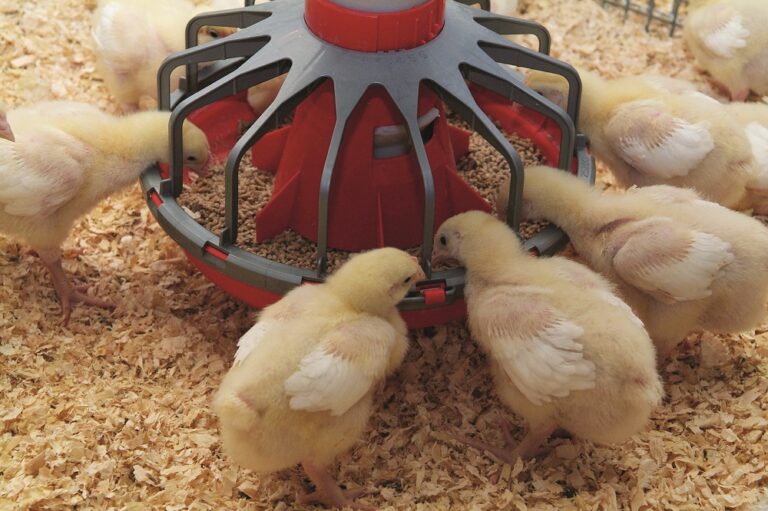By Kevin Stebbings, UK Technical Services Manager, Aviagen
Getting chick start right is vital to ensure the health, welfare and good performance of a flock. Optimal feeding is one of the most critical aspects contributing to successful brooding. Not only is this a period when critical growth takes place in the skeletal and cardiovascular system, but also when there is a proliferation of satellite cells, which are essential for muscle growth and repair.
In essence, chicks should have access to food and water as soon as possible post-hatch to maximise their genetic potential. A simple method to assess your chick start is to look at the difference between day-old and 7-day chick weights; ideally you should achieve a minimum of 4½ times increase.
During the first seven days a chick undergoes the following developmental stages:
- Appetite development.
- Intestinal and gizzard development which is key to obtaining high feed efficiency.
- Organ and skeletal growth followed by muscle growth (i.e., the liver matures rapidly in order to transition from fatty, rich yolk to a predominantly carbohydrate diet).
- Digestive tract and immune system development – stimulated by the right feed and feeding behaviour.
Feed quality is the key to good health. Poor feed will introduce challenges to a chick’s health and well-being, such as:
- Impaired growth due to poor nutrient absorption.
- Vulnerability to bacterial challenges such as E. coli, Salmonella and Campylobacter.
- Reduced feed efficiency and weight gain.
- Less resilience to environmental factors (i.e., temperature and humidity changes).
- Poor digestive tract and immune system development.
Therefore, it is important to get feed form and regime correct:
- Pre-start (crumb) should be easy to digest and of good physical quality to enhance feed absorption. Chicks consuming higher levels of fines (particles below 1 mm in size) will waste more feed, reducing feed efficiency.
- A well-textured crumb followed by a quality pellet will aid gizzard development for gut motility.
- Initially, textured feed should be provided as a dust-free crumb and placed on top of feed paper at approximately 85 grams per bird.
Additionally, to help birds transition from supplementary to automated systems, put paper on both sides of the automated feeding system. Be sure to place chicks directly onto the paper so they find the feed immediately. Paper not only has the advantage of preventing chicks from eating the litter material, which would result in a poor start, but also promotes feed intake due to its noise association. By day three, the chicks should be accessing the automated feeding system.
Good stockmanship takes into account management of various environmental factors. The farm manager should monitor and make necessary adjustments to temperature, relative humidity, CO2 levels and ventilation, in line with bird behaviour and age. It is essential to observe the birds closely and react to their requirements instead of being governed by automatic controls.
Water is a key nutrient involved in feed intake. Without clean, fresh water that is readily available, feed intake will be affected.
Temperature. Temperature plays an important part in optimising feed intake. While it’s difficult for day-old chicks to regulate heat production, they are able to influence their heat loss. At low body temperatures, chicks huddle together to minimise their total surface and in effect prevent excessive heat loss. If temperatures are too high, chicks move to outside walls and away from feeding systems.
Lighting. As with temperature, uniform light distribution through the house is critical to achieving uniform feed and water intake.
TOP TIPS
Check vent temperatures
A simple method for assessing chick comfort in the first two days of life is to measure vent temperatures, which should be between 39.4 – 40.5°C.
Check crop fill
Monitoring crop fill during the first 24 hours after placement is helpful in assessing your chick start success. The prime focus should be on maximising crop fill during the first few hours – the table below gives a guideline.

If crop fill targets are not being met, the farm manager should review chick start procedures to ensure the birds have good access to food and water. If crop fills are lower than target, all environmental factors should be taken into consideration.
Getting off to a good start
The first 48 hours are crucial to stimulate healthy chick development and provide birds with everything they need to reach their best potential. Focusing on food and water, feeding behaviour and environmental conditions will help ensure that chicks get a sound start to life, which will maximise bird performance, health and welfare.


